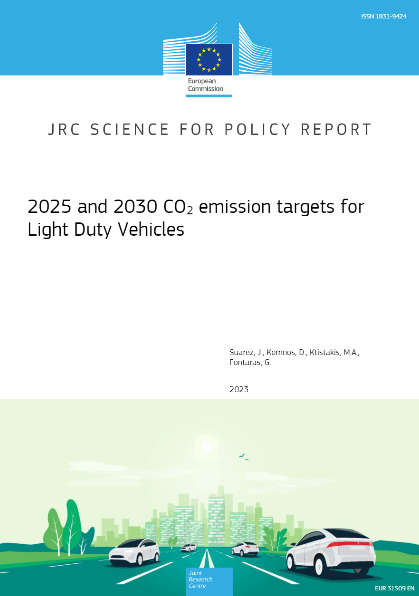
Resumen:El transporte por carretera es el principal responsable de las emisiones de dióxido de carbono (CO2) en la Unión Europea (UE). Los turismos y los vehículos comerciales ligeros (VCL) representan casi el 15% de las emisiones totales. Con el fin de descarbonizar gradualmente el parque, la UE ha establecido objetivos de CO2 para todo el parque de vehículos matriculados anualmente, asignando a los fabricantes objetivos específicos basados en la masa media de sus vehículos. A partir de 2025, se establecerán nuevos objetivos para todo el parque de la UE aplicando un porcentaje de reducción a un objetivo de referencia para todo el parque de la UE de 2021. Este valor se calcula a partir de las emisiones de CO2 de los vehículos para 2020 y las cifras de masa y matriculación de 2021. En 2025, la reducción será del 15% tanto para los turismos como para los vehículos industriales ligeros, mientras que para 2030 aumentará al 55% y al 50%, respectivamente, tras la reciente adopción de los objetivos más ambiciosos. Este informe proporciona el método sólido utilizado para calcular los objetivos del conjunto del parque de la UE en 2025 y 2030 y los parámetros que definirán la línea de objetivos específicos de los fabricantes a partir de 2025. Los objetivos para el conjunto del parque de la UE calculados para 2025 son 93,6 g/km para los turismos y 153,9 g/km para los vehículos industriales ligeros. Para 2030, los objetivos se reducirán a 49,5 g/km para los turismos y 90,6 g/km para los vehículos industriales ligeros. La pendiente de la línea objetivo para 2025 será de -0,0144 g/(km∙ kg) para los turismos y de 0,0848 g/(km∙ kg) para los vehículos industriales ligeros, mientras que para 2030 la pendiente será de - 0,0076 g/(km∙ kg) y 0,0499 g/(km∙ kg), respectivamente.
Summary:Road transport is the main contributor to transport emissions of carbon dioxide (CO2) in the European Union (EU), with passenger cars and light commercial vehicles (LCVs) accounting for almost 15% of the total emissions. In order to gradually decarbonise the fleet, the EU has established fleet-wide CO2 targets for annually registered vehicles, assigning manufacturer specific targets based on their average vehicle mass. From 2025, new EU fleet-wide targets will be established applying a percentage reduction to a reference 2021 EU fleetwide target. This value is calculated from the vehicles’ CO2 emissions for 2020 and the mass and registration figures of 2021. In 2025, the reduction will be 15% for both passenger cars and LCVs, while for 2030 it will increase to 55% and 50%, respectively, following the recent adoption of the more ambitious targets. This report provides the robust method used to calculate the EU fleet-wide targets in 2025 and 2030 and the parameters that will define the manufacturers’ specific target line from 2025 onwards. The EU fleet-wide targets calculated for 2025 are 93.6 g/km for passenger cars and 153.9 g/km for LCVs. For 2030, the EU fleet-wide targets will be reduced to 49.5 g/km for passenger cars and 90.6 g/km for LCVs. The slope of the target line for 2025 will be -0.0144 g/(km∙ kg) for passenger cars and 0.0848 g/(km∙ kg) for LCVs, while for 2030 the slope will be - 0.0076 g/(km∙ kg) and 0.0499 g/(km∙ kg), respectively. An indicative 2025 average test mass of 1,609.6 kg for cars and 2,163.0 kg for LCVs, was calculated.
Fecha publicación: 2023
Autor: Centro Común de Investigación; Suarez, J ; Komnos, D ; Ktistakis, M.A ; Fontaras, G
ISBN / ISSN: 978-92-68-03448-4 / 1831-9424
Link: https://n9.cl/nc73q
Palabras clave: automóvil , carburante , consumo de energía , contaminación por vehículos automotores , gas con efecto invernadero , informe , lucha contra la contaminación , norma medioambiental , reducción de las emisiones de gas , vehículo industrial
Keywords: car , fuel , energy consumption , environmental standard , greenhouse gas , report , environmental standard , greenhouse gas emission reductions , automotive , greenhouse gas emissions , car , car industry , fuel , gas emission reductions , commercial vehicle , pollution from motor vehicles
